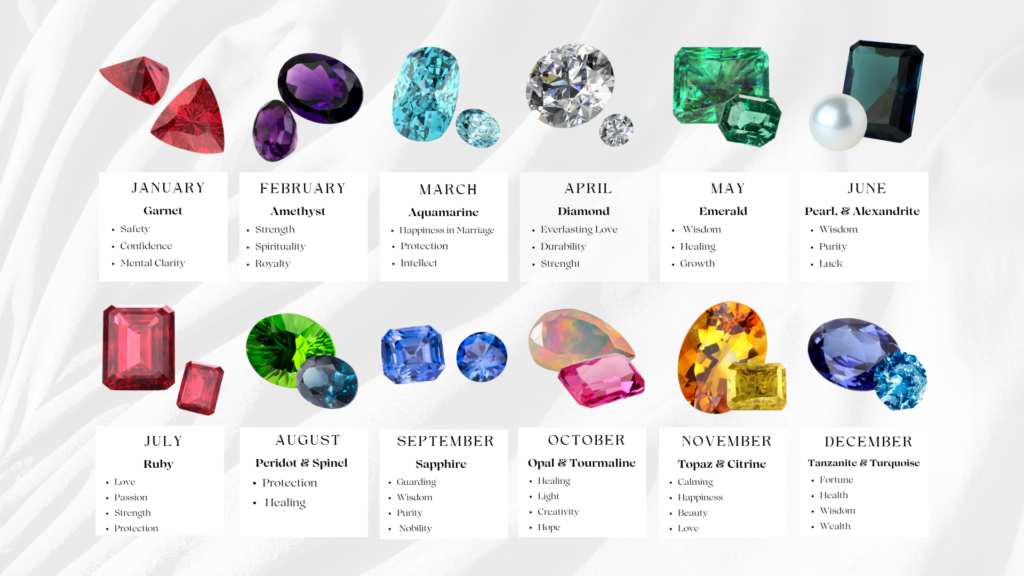We all struggle with finding the perfect birthday gift for our loved ones. Birthstones are one way to surprise someone with a thoughtful and fitting present. Regardless of gender, age, nationality, or religion, birthstones resonate with people, making them highly appealing. Each birth month has one or more birthstones to choose from. Birthstones are surrounded by myths and legends about their powers, properties, and attributes. Below is a chart displaying the birthstones associated with each month and their attributes.

January’s birthstone Garnet was used in ancient Egypt for Pharaos while in Rome they were used in signet rings with garnet intaglios to stamp the wax that secured important documents. Although garnets are typically red, they exhibit a variety of captivating colours, including orange, yellow, purple, and vibrant green. The clergy and nobility of the Middle Ages preferred red garnets.
Amethysts were loved by royalty due to the purple colour of the gemstone. February’s birthstone is also connected to Greek mythology and the God of Wine, Bacchus. This gemstone derives from the Greek amethystos, which means “a remedy against drunkenness,” and is supposed to help people sober up after drinking.
The Aquamarine birthstone derives from Latin and stands for seawater. This stone was believed to protect seaman at sea and calm the waters. This March birthstone was to shield the wearer from enemies in combat and legal disputes, instil invincibility, and charm while enhancing cognitive abilities.
Coming to the most popular and sought-after gemstone, the diamond symbolises clarity and strength. Its name derives from the Greek word adamas,” which means “invincible” or “unbreakable. The tale of the diamond began in India, where diamonds were collected from rivers and streams. From the fourth century BCE onwards, diamonds were highly sought after and primarily desired by the wealthy and royalty. By the 1400s, diamonds gained popularity as fashionable adornments among Europe’s upper class. In 1477 Archduke Maximillian of Austria gave the first historically recorded diamond engagement ring to his betrothed, Mary of Burgundy.
May’s birthstone Emerald has been a long enchanting royalty. From Incas to Egypt, the Emerald was used in many pieces for royalty, especially by Cleopatra as she had a passion for the striking green gemstone. The name Smaragd is another vocabulary for the emerald and was mostly used in ancient Egypt.
June has two birthstones, the Alexandrite and the Pearl. Pearls originate from oceans, lakes and rivers. They are loved by women of all ages and are considered a timeless wardrobe staple. Pearls were believed by the ancients in the Middle East to be tears that had fallen from the sky while The Chinese had a belief that they originated from the brain of a dragon. The alexandrite is a rare variety of a mineral called chrysoberyl which changes the stone’s colour depending on the lighting. They were discovered in Russia’s Ural Mountains and were named after the young Alexander II.
Rubies represent the essence of life, power, and youthful vitality in Indian jewellery, earning them the title of “the ruler among precious gemstones.” They are also known for their rarity, hardness (second only to diamonds), beauty and seemingly mystical powers. The birthstone associated with July was thought to foretell bad luck or potential harm, while some believed it had healing properties for inflammatory diseases and could help calm anger. Burmese fighters adorned these garments with the conviction that they bestowed invincibility during combat. During Medieval times in Europe, it was believed that rubies bestowed health, wisdom, wealth and success in love.
August’s birthstones are both Peridot and Spinel. Peridots are recognised for their formation in harsh environments, such as being discovered in solidified lava transported from the Earth’s mantle and in meteorites originating from outer space. The peridot gemstone held great significance in various ancient and medieval societies. It adorned the jewellery of priests dating back to the second century BCE and was later incorporated into the chalices and churches of medieval Europe. For centuries, the peridot birthstone was a powerful talisman, safeguarding its wearer against evil spirits and the fearsome darkness of the night.
The second birthstone is the spinel which comes from the Latin word spina, meaning thorn relating to the shape of spinel crystals. This gem comes in various colours: red, pink, orange, purple, violet, blue and bluish-green. Spinel was once thought to possess healing properties for various blood loss and inflammatory conditions, aiding anger management and fostering a sense of harmony.
“Sapphire” comes from the Greek word sappheiros and the blue sapphire is the most popular coloured stone. September’s birthstone traditionally symbolised sincerity, truth, faithfulness and nobility while associated with royalty and romance. Blue sapphires were believed to offer protection and ward off envy in ancient Greece and Rome, while in the Middle Ages, sapphires were worn by clerics as a symbol of Heaven. According to the ancient Persians, the sky’s blue colour was attributed to the earth being upheld by a massive sapphire.
October’s birthstones are Opal and Tourmaline. Opals are valued for their shifting colours in rainbow hues. Ancient Greeks thought opals possessed the gift of prophecy and protection from disease. In Europe, the opal is associated with purity, hope and truth. Similarly to the opal, the tourmaline gemstone often has multiple colours in one crystal. according to ancient mystics, this birthstone was believed to be a source of inspiration for artistic expression. It offers a wide range of colours to suit every mood, with popular options including pink and red rubellites, emerald green “chrome” tourmalines, and neon green and blue-to-violet “paraíba” tourmalines.
Topaz and Citrine are both November’s birthstones. Topaz is available in various colours, while citrine is valued for its attractive yellow and orange tones. Both November birthstones have calming energies while bringing fortune and warmth to the wearer. Ancient Greeks believed that topaz gave them strength, while in Europe it had the power to counteract magical spells and dissipate anger. In India, the topaz was worn above the heart to ensure long life, beauty and intelligence. Citrine is believed to have the same powers as topaz, soothing tempers and calming down the wearer.
December’s birthstones Turquoise and Tanzanite are striking in their intense blue colours. Tanzanites were blue gems emerging from Tanzania, identified as the mineral zoisite in 1962. The tanzanite birthstone is frequently characterised as having a “velvety” appearance due to its intense and saturated colour spectrum, ranging from a deep blue to violet, with the blue shade being the most prized. The second birthstone Turquoise is a gemstone that can be either semi-translucent or opaque. It comes in multiple colours, ranging from blue to green, and often contains veins of the matrix, which are remnants of the rock in which it was formed. It has been cherished for millennia as pharaohs and other rulers of ancient Egypt adorned themselves with it. Many ancient cultures thought it possessed many beneficial powers, like guaranteeing health and good fortune.
These gemstones are not exclusive to each month and can be purchased however you like. If you desire a diamond for your loved one born in November, don’t hesitate to do so. Consider gifting a gemstone that embodies a specific attribute or power to someone you believe would suit them most. Explore our bespoke service or browse our collections to discover the perfect diamond gift for your special someone, a beloved friend, or a family member.

